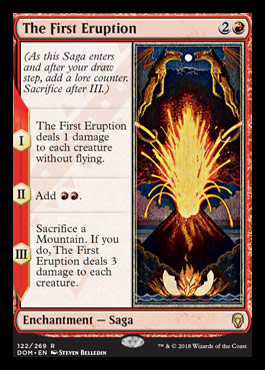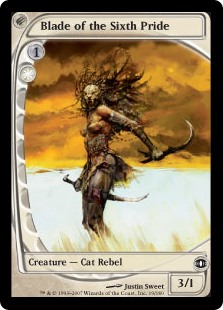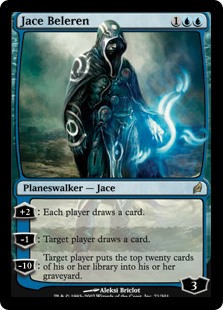Dominaria is returning next month. The big new innovation appears to be vertical enchantments called Sagas. Rob wrote a great analysis of their story-telling potential. Mechanically, the Sagas allow for dynamic progression on a card without resorting to clunky implementations like Level Up. But what do the cards look like?
The visual element of the Sagas is striking and new. For the first time in Magic, we have truly vertical cards. But wait—aren’t all Magic cards vertical? The whole point of the tapping mechanic at the heart of the game is that cards are played on the battlefield vertically, while being turned sideways (horizontal, slanted, whatever) had game significance. The only “horizontal” cards in the game are split cards like Fire // Ice, which are never permanents. That’s all true, but the flow of information on previous cards was always horizontal, like reading. The back of a Magic card is a book, the deck is a library, and we read the cards from top to bottom.

Now that is a vertical card! The rules text go down, down, down—aided by the arrow-like taper of the Roman numeral bar on the left. On the right side, we get a strongly vertical illustration. I’m a little thrown off that eruptions go up—indeed the entire piece goes up—while the three tiers of art correspond with the downward progression of the rules text. Fliers-mana-boom. Still, the card works very well on a visual level.
It’s notable that this new vertical card structure debuts on a set of enchantments. That is the one permanent type that doesn’t tap. Yes, there are a few Future Sight enchantments like Witch’s Mist that can tap, as well as enchantment-creatures like Courser of Kruphix and a few enchantments that can turn into other permanent types and become tapped. But for all practical purposes, enchantments don’t tap. It’s not like you couldn’t tap one of these Saga cards—they’d look fine turned sideways—but there is nothing about the Sagas that suggest horizontal motion.
Compare the Saga layout to the “full art” Future Sight vanilla creatures with new frames:

The fake “new frame” of Future Sight has a vertical feel. It resembles the layout of the Sagas in a few ways, but the full vertical illustration only fits because there is no text box. Cards like Ghostfire lose this effect. Similarly, full-art lands provide more dynamic illustration space, but are just taking advantage of a lack of rules text. That’s not deep design space, shall we say.
Going a little deeper on the Sagas though, they feel more like sorceries than enchantments. It makes sense mechanically to represent them as permanents—if only for a few turns—rather than messing with some sort of Suspend/Rebound mechanic on a sorcery with multiple effects. And yet they feel like enchantments too, like temporary spells that have taken hold of the game. In that way, they harken back to the Enchant World mechanic from Legends, where each successive card of that type would replace the last.
Perhaps the Sagas represent a blending of the flavor of enchantments and sorceries? That’s a cleaner mechanical implementation of multi-turn spell-like effects than previous attempts, and the flavor fits. I like this bold experimentation. But are there other card types where this could expand? Instants are basically sorceries, but they make less sense to be “permanent” multi-effect spells, and they would interact weirdly with the draw-step counter mechanic of Sagas. I don’t think there’s room to slap “Flash” into the rules text of a Saga either. And yet, there is one card type that the Sagas remind me of quite a bit:

Don’t planeswalkers look like they could have been designed with a vertical card? They already have an extended art box, at least when they aren’t overloaded with abilities like Jace, the Mind Sculptor, which features the standing pose of the character. The standard horizontal design we have works better for heavy-text loyalty abilities, perhaps, but the setup of three vertical abilities tracked with a counter is similar.
How long has Wizards been toying with this vertical card setup? I bet the Saga mechanic has been waiting a while to see the light of day. Some have noted its similarity to the Contraption mechanic from Unstable, which is a good point. But the general space of “things that sit on the battlefield and change over time but aren’t creatures” is fertile ground for Magic to develop. I look forward to seeing what it feels like to have a Saga in play, and to what further vertical designs we see in the future.
Carrie O’Hara is Editor-in-Chief of Hipsters of the Coast.

